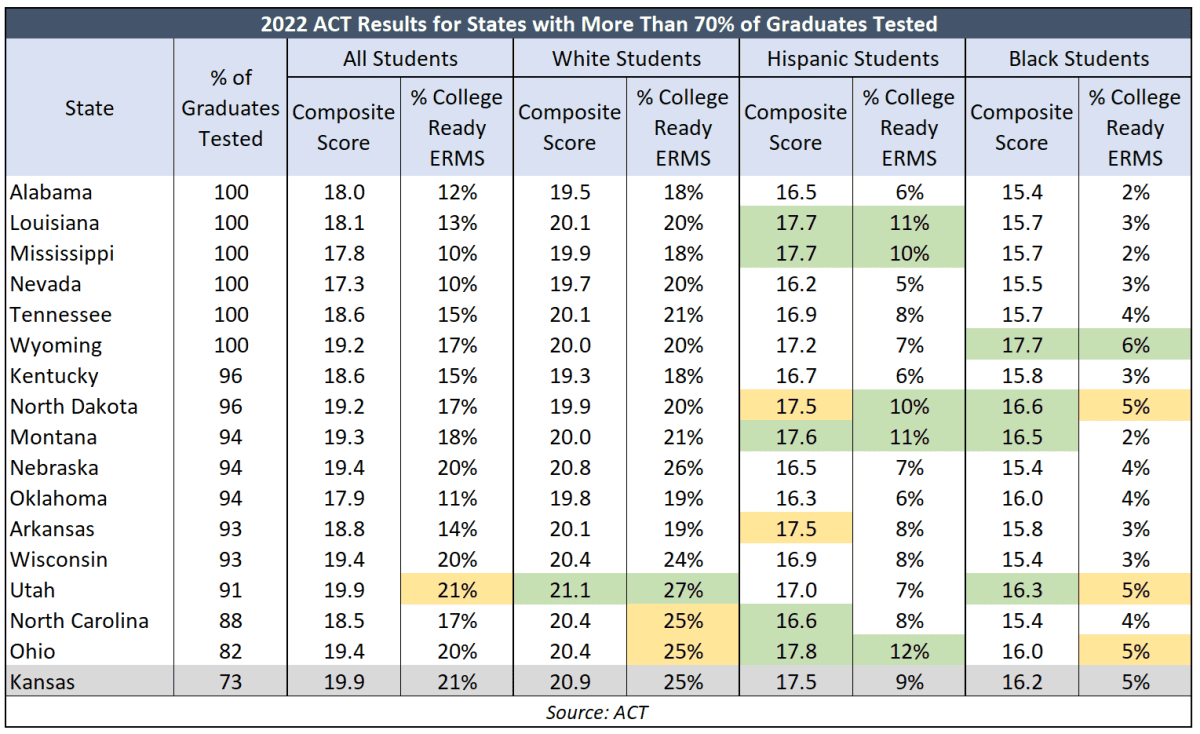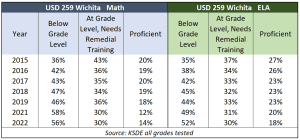USD 259 superintendent Kelly Bielefeld spoke to the Wichita Pachyderm Club recently, and like his predecessors, he went out of his way to hide poor student achievement for the district and the state overall.
Bielefeld gave just one statistic for outcomes in the Wichita school district – an ACT score of 16.8. He said the state score of 19.9 was the best among the states with more than 70% of graduates taking the test. That is true, but also horribly and consciously deceptive.
First of all, the Kansas results are not good. Only 21% of those who took the test were considered college-ready in English, Reading, Math, and Science. That is well below the national average of 25% and a steep decline from 2015, when 32% were college-ready.

State participation in the ACT can make a difference in average scores. In states with low participation, those taking the test are probably the most likely to attend college and likely have better proficiency levels. Therefore, the average score for those states can be artificially higher than if all students took the ACT.
Demographic differences among the states can also skew state averages because of significant achievement gaps between White students and others. Kansas is one of those states and has a high percentage of White students, whereas White students are the minority in some states. As we’ve said many times, these tragic gaps aren’t because these children cannot learn; the gaps exist because these children have not had much-needed opportunities.
ACT also measures college readiness, which is more relatable than a raw score on a scale of zero to 36. On that basis, one of the 70%+ participation states, Utah, ties Kansas for overall college readiness in English, Reading, Math, and Science at 21%. But Bielefeld didn’t mention this disturbing fact because it tells a different story. Being better than other states is meaningless when only 21% of your graduates are college-ready.
The demographic stories are even worse.

Utah has better college readiness for White students (27% vs. 25%), and two states – North Carolina and Ohio – are tied with Kansas.
Only 9% of Hispanic graduates in Kansas were college-ready, and five states – Louisiana, Mississippi, North Dakota, Montana, and Ohio – do better. Just 5% of Black students are college-ready in Kansas, which is matched by Ohio, Utah, and North Dakota and bettered by Wyoming.
Bielefeld didn’t say how the Wichita district does on the state assessment, probably because those results tell a different story than he wanted Pachyderm members to hear.
 Over half of all students tested (grades 3 through 8 and 10) are below grade level in Math and English Language Arts; 15% are proficient in math and 18% in ELA.
Over half of all students tested (grades 3 through 8 and 10) are below grade level in Math and English Language Arts; 15% are proficient in math and 18% in ELA.
The high school results for USD 259 explain why college readiness is so low.
In math, 66% are below grade level, and only 9% are proficient; 58% are below grade level in ELA, and 13% are proficient.
Poor state assessment results and having just one in five college-ready graduates in English, Reading, Math, and Science is a serious problem that won’t change if education officials refuse to publicly acknowledge it. We need education leaders to embrace the student achievement crisis with a no-one-is-to-blame-but-everyone-is-responsible credo. The tyranny of low expectations must be overcome with the fierce urgency of now. Identify the barriers preventing students from being proficient and implement the budgetary changes to overcome the obstacles so every student can get a good education.




